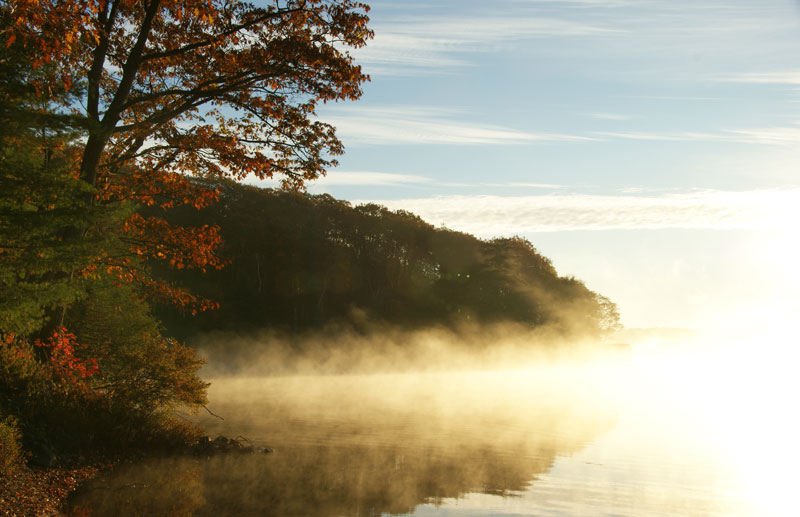Click here to Subscribe to Chips Tips Blog
How To Close a Cottage For The Winter

How To Close a Cottage For The Winter
Fall is in full swing here in Northern Ontario. Oh how we’ve missed the vibrant fall colours, crisp autumn air and foggy lake views.
Those fond memories of summers at the cottage are likely still fresh, but it's just about time to close your cottage down for the season.
If you’ve owned a cottage for a while, you likely know the drill to a successful cottage closing. But if this is your first, or even second, year with the responsibility, keep reading!
Our GPHE team has done it for years - we know all there is to know about a successful closing. And we’re here to help you get the job done right!
Whether you’re new to seasonal cottage upkeep or just need a few professional pointers, we’re here for you!
In this article, we’re offering our favourite tips for a speedy and seamless cottage closing.
Psst…if you’re looking for tips on how to winterize a cottage, you’re in the wrong spot! But our team is happy to help you with that as well!
When to Close Your Summer Cottage
Choosing when to close your summer cottage can be confusing. Maybe just as confusing as how to close a cottage for the winter!
After all, Canada’s seasonal transitions have never been so unpredictable.
Temperatures jump from 5 degrees Celcius to 29 in a single week. So there’s no telling when that last cottage weekend will be!
That’s why it’s best to plan ahead.
Traditionally, cottage owners have aimed to have a seasonal cottage closed and winterized no later than Thanksgiving weekend. However, with the recent warm temperatures, many families have actually opted to host their Thanksgiving dinners at their cottage!
It all depends on the arrival of that first snowfall.
Close your cottage too early, you miss out on some of the prettiest weather of the whole year!
Close too late and every step of the cottage closing process becomes harder.
We typically recommend you close down your cottage,
- As soon as your fall schedule becomes too busy to visit the cottage regularly, and
- Before the first snowfall.
This way, you have ample time to attend to each critical item!
Speaking of which…
Below are two cottage closing checklists. The first is your MAJOR checklist - this has all the non-negotiables.
The second is your MINOR checklist - this has the items that are significantly less important to complete. If you have extra time on your hands, go for it! But if not, focus on your major list.
Major Cottage Closing Checklist
Forget or skip these items and you may return in the spring to some expensive repair jobs.
1. Drain and wrap your pipes.
Guarding against frozen and bursting pipes over the winter season is crucial.
We recommend draining the water from your pipes and shutting off the main water valve to prevent this.
2. Leak-proof your hot water heater.
Your hot water heater is more sensitive than you might think. Only by draining and turning it off can you be sure it won't spring a mid-winter leak.
3. Defrost your fridge/freezer.
Unplug your fridge and leave the doors slightly open to prevent mould and mildew.
Then, don’t forget to remove all food - even canned items! Food can freeze and/or spoil - attracting unwelcome wildlife into your cottage.
4. Prepare your septic/sump system for winter.
Preparing your septic/sump pump system for winter is crucial. But the steps you can take depend on,
- The height of your water table and
- Whether your pipes pump uphill or downhill.
Ask one of our plumbing experts how to winterize your particular system!
5. Wildlife-proof your roof, vents, main cottage, and storage shed areas.
Rodents and insects are eager to take shelter in your cottage when temperatures drop.
To prevent this, we recommend taking the following precautions:
- Re-seal old caulking,
- Install vent screens and
- Close your chimney flue.
6. Take in and secure all equipment, furniture, docks, vehicles, and gear.
Store all equipment inside a secure shed to prevent them from winter damage.
Don’t forget to ensure you factor in the possibility of rising water when deciding where to store these valuable items.
7. Secure any items to be left outside during winter.
Do you have items that are too large to move easily or that you have no storage space for? Secure them in some way to your cottage property - chains and a heavy-duty lock often work well!
8. Make a decision about your main power supply.
Some cottage owners leave their main power supply on for things like their security systems or safety lighting.
This is completely up to you!
If you do decide to unplug completely, however, don’t forget to unplug each appliance individually as well.
9. Check to be sure all seasonal vehicle and cottage insurance is up-to-date.
Insurance may not be the most fun part of owning a seasonal cottage. But it sure comes in handy when your cottage or recreational vehicles become damaged, vandalized, or stolen!
Minor Cottage Closing Checklist
Other items on your cottage closing checklist are less critical in terms of cottage safety and security.
Getting them done, however, will definitely make your life easier during spring reopening!
1. Winterize your lawn and garden.
Preparing your cottage property for the winter is just as important as it is at home.
Preparing your cottage property for the winter:
- Clear out old foliage in and around our property.
- Mow the lawn one last time.
- Weed the garden(s).
- Add a layer or two of protective mulch to insulate your garden over the winter.
2. Clean out and winterize your fireplace.
If you have a working fireplace, any leftover debris will become a winter critter magnet.
Cleaning, repairing, and oiling all fireplace and flue mechanisms make it much easier to reopen in the spring.
3. Give your cottage itself a good pre-winter cleaning.
This includes wrapping pillows, mattresses, cushions, and linens in plastic to keep dust mites and other tiny creatures out.
Pro Tip: Place fabric softener sheets inside the plastic to act as a further repellant!
Book Professional Cottage Closing With GPHE
At GPHE, our goal is to make your seasonal cottage opening and closing as straightforward and simple as possible!
Need professional guidance on your particular cottage fixtures? Running out of time? We can help!
We can tell you how to close a cottage for the winter, or we can get the job done for you!
Book a professional cottage closing with our GPHE team this fall.

